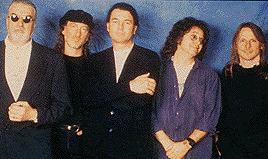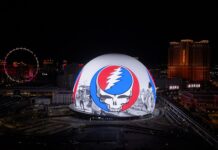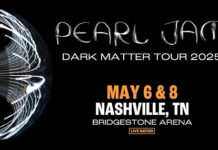Review by Shawn Perry
Deep Purple is a dinosaur that refuses to die. That’s the only way I can assess their continued existence. Unlike other bands who have stuck it out over the course of two or three decades, Purple have narrowly deviated from their style, despite a number of changes in key personnel. It’s almost as if this band is synonymous with their particular brand of hard-driving British rock, and couldn’t possibly dream of being looked upon in any other light. It would be too out of character, too unPurple-like. And for devotees of this 30 year-old beast, that’s fine.
With Ritchie Blackmore out of the fold again(!), you’d have thought this would have placed the band’s future in a quandary of confusion. Twenty-two years ago, when Blackmore left the first time, an able-bodied Tommy Bolin — a hot shot fusion funkster who had slam-dunked some infamous guitar work with everyone from James Gang to Billy Cobham — couldn’t seem to fuel the fire that slowly burned out in the wake of Machine Head and Made In Japan — stand-outs in a patchy catalog of hits and misses. For all his quirky faults, Blackmore was clearly an integral part of Purple’s initial success. Without question, “Smoke on The Water” is, to this day, one of the all-time famous riffs of the twentieth century. In some music stores, you’re not even allowed to play it. That’s the ultimate compliment.
Ian Gillan, the voice who bellowed out the autobiographical lyrics to the band’s most famous song, is pretty much the reason Blackmore headed for the hills. Apparently, Ritchie can’t stand Ian, and supposedly issued an ultimatum with regard to who was staying and who was leaving. Gillan’s unmistakeable yelp is a tough forgery. Forget the guy who sang “Hush,” the band’s first hit in 1968 — I think it’s Rod something-or-other — he hasn’t shown his face since an ill-fated tour in the 70’s when he tried to cash in on Purple’s success, some 8 years after he was in the band. Purple’s third vocalist, David Coverdale, would become better known as the leader of Whitesnake and an ill-fitting Robert Plant impressionist. Come to think of it, he hasn’t done much since Jimmy Page went back to the real article, so let’s move on. In 1990, Fans couldn’t be bothered when Blackmore tried to replace Gillan with Joe Lynn Turner, who had already displaced Ronnie James Dio in Rainbow. But that’s another story…
This time, Gillan remains, and the band brought in another hot shot guitarist by the name of Steve Morse. As a founding member of the Dixie Dregs and solo artist with a sizable following of his own, Morse has made a soothing transition with a commanding impact in the group’s turbulent 30 year cycle. It’s almost as if they are possessed with a renewed sense of urgency and desire, with their sights on establishing Deep Purple as much of a powerful, dynamic and viable force in the late 90’s as they were in the early 70’s.
The Perpendicular album of 1995 didn’t quite make the sought-after, propitious dent in the charts, but the mighty Purps have nonetheless trudged onward, becoming a touring powerhouse that’s covered the world, bent on its promise of delivering high doses of potent vintage rock…Purple rock. The fans who packed in for four consecutive, sold-out nights at the fabled House of Blues on the Sunset Strip in Hollywood were witness to that.
It was nice to see the wide-eyed grin of Morse wailing through such obscure classics as “Bloodsucker,” Into The Fire,” “Speed King,” and “No One Came” interspersed with such high-brow fodder as “Woman From Tokyo,” Highway Star” and the ever-nagging “Smoke…” A guitarist of indefinable dexterity and unarmed discernment, Morse put such a positive spin on the proceedings, it was impossible to ignore the upbeat mood of the everyone else on stage. It was certainly an inspiring contrast to the sullen moods of Richie Blackmore.
Jon Lord, the undisputed monster of the Hammond B-3, however old he may be — and he looks like he’s sucked down a fair amount of the good life in his time — can still light a fire under his Leslie, and frolic through each passage with the skill of a studied virtuoso. Clearly, Lord may be the only member of Deep Purple they could never replace. Luckily for them, they’ve never had to.
Drummer Ian Paice is as ageless and flawless as ever. Along with Lord, Paice has never been a high-profile “rock star”, and has played on every Deep Purple album. You never realize how essential Paice is until you see him playing as steadily and sure as a stop-watch. Meanwhile, bassist Roger Glover, who has been remastering a bulk of Purple’s classic catalog for release, pounds out the bottom line with resounding conviction. As a long-time comrade of Blackmore’s (they were in Rainbow together) it was interesting to see how enthusiastically Glover interacted with Morse on a number of occasions.
As for Ian Gillan, his presence was prominently felt. For the most part, Gillan was in fine form, occasionally straining for notes no longer within his range, but keeping things at a manic pace, even distributing small cups of beer to stage-side spectators. The only big gripe I have are the oversized congas Gillan insists on setting up at center stage. I’ve never understood the part these congas play in the Deep Purple saga. Gillan is seen maniacally scrubbing away on them on the cover of Made in Japan. But whenever I put on that CD, I never hear them. Blackmore and Lord are sonically ions beyond Gillan, while Paice pretty much has the percussion nailed down and shut tight.
On the small stage of the House of Blues, Gillan’s congos stood, blocking my view of Paice, without serving any useful purpose otherwise. When he wasn’t singing, Gillan flailed away, his hair swinging back and forth, in unison with the beat, and the density of his own absurd attempt at playing an instrument. He must get bored during the solos, and feels inadequate at his inability to participate. Ian — you can stick with the harmonica, just get rid of those stupid congos.
Where Purple excelled was with their new material. However inane Gillan’s lyrics are on “Ted The Mechanic” or “Rosa’s Cantina,” his voice seemed to swing gracefully within the lines laid down by Morse and Lord. Amdist a Purple framework, there is plenty of Morsefuls with each bite. Instead of trying to replicate Blackmore, Morse would often reel off country-fried, Dreg-esque solos, breathing new life into what many wayward trendsetters would dub as over-the-hill heavy metal, speed riffs. Yeah, but what do they know anyway?
Purple even managed to sneak out a new tune called “Seventh Heaven.” It was, as could be expected, chock full of Purpleness, confirming that this edition of Deep Purple (Mach IV by my count) has every intention of carrying on — if the magic persists and an audience still shows up. Beginning a half-hour before midnight, and playing clear past quarter to one in the morning, Deep Purple played as if they’ll never give into the fight of staying valid in rock and roll.




















